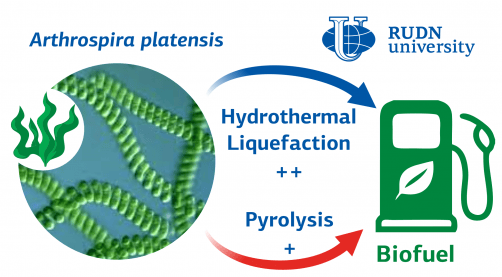
by Russian Foundation for Basic Research
RUDN ecologists compared the main methods for obtaining biofuel from microalgae and named the most effective one. Chemists took into account both the process of preparing raw materials, the yield of the final product, and the energy costs of synthesis.
The synthesis of biofuels, which should replace conventional fuels, need to be green. Therefore, scientists continue to look for new protocols that will increase the efficiency of biofuel production and make it as environmentally friendly as possible. There are two main approaches to obtaining fuel from biomass: pyrolysis and hydrothermal liquefaction. The first involves thermal decomposition of dry biomass without access to oxygen and at high temperature. In hydrothermal liquefaction, wet biomass is heated under pressure. This is how oil is formed in natural conditions. Environmentalists from RUDN University, Moscow State University, the Joint Institute for High Temperatures of the Russian Academy of Sciences and Graphic Era University (India) compared these approaches for obtaining fuel from cyanobacteria, or microalgae.
“Energy producers face the challenge of obtaining a product that is not only competitive, but also produced with minimal carbon footprint. Microalgae biomass is a renewable non-food resource that is considered a promising feedstock for biofuel production. It gives high performance and at the same time does not compete with food and feed. Despite the huge successes of recent years, the implementation of this process remains a challenge due to the high price of biofuels produced. Therefore, it is important to increase the competitiveness of the conversion of biomass to biofuel,” Mikhail Vlaskin, PhD, Leading Researcher at the Department of Environmental Safety and Product Quality Management, RUDN University.
Ecologists chose microalgae Arthrospira platensis as it is easy to obtain. Pyrolysis was carried out at temperatures of 300, 400, 500 and 600 degrees. Hydrothermal liquefaction took place at temperatures of 270, 300 and 320 degrees.
The yield of biofuel during hydrothermal liquefaction turned out to be much higher, 38.8 – 45.7% versus 21.9% during pyrolysis. In addition to the liquid fraction, biochar is also formed in both processes. Its yield was almost the same – about 27%. Biochar has an additional useful function – it can act as a filter, absorb carbon dioxide and prevent it from escaping. RUDN University environmentalists have called hydrothermal liquefaction the preferred technology. Another advantage is that there is no need to pre-dry the biomass before liquefaction, as is the case with pyrolysis. As a result, energy costs for biofuel production are reduced by at least 35%.
“Hydrothermal liquefaction is preferable in terms of products obtained. In addition, it is only necessary to collect the biomass, not to dry it. The process itself can be optimized to achieve a higher thermodynamic efficiency,” Mikhail Vlaskin, PhD, Leading Researcher at the Department of Environmental Safety and Product Quality Management, RUDN University.
Reference (open access):
Chernova, Nadezhda I., Anatolii V. Grigorenko, Sophia V. Kiseleva, Olga M. Larina, Vinod Kumar, and Mikhail S. Vlaskin. 2022. “Comparative Evaluation of Pyrolysis and Hydrothermal Liquefaction for Obtaining Biofuel from a Sustainable Consortium of Microalgae Arthrospira platensis with Heterotrophic Bacteria” Processes 10, no. 11: 2202. https://doi.org/10.3390/pr10112202
Editor at the digital magazine AquaHoy. He holds a degree in Aquaculture Biology from the National University of Santa (UNS) and a Master’s degree in Science and Innovation Management from the Polytechnic University of Valencia, with postgraduate diplomas in Business Innovation and Innovation Management. He possesses extensive experience in the aquaculture and fisheries sector, having led the Fisheries Innovation Unit of the National Program for Innovation in Fisheries and Aquaculture (PNIPA). He has served as a senior consultant in technology watch, an innovation project formulator and advisor, and a lecturer at UNS. He is a member of the Peruvian College of Biologists and was recognized by the World Aquaculture Society (WAS) in 2016 for his contribution to aquaculture.
